Technical (vehicle)
A technical, in professional military parlance often called a non-standard tactical vehicle (NSTV), is a light improvised fighting vehicle, typically an open-backed civilian pickup truck or four-wheel drive vehicle mounting a machine gun, anti-aircraft gun, rotary cannon, anti-tank weapon, anti-tank gun, ATGM, mortar, multiple rocket launcher, recoilless rifle or other support weapon, somewhat like a light military gun truck or potentially even a self-propelled gun.

The neologism technical describing such a vehicle is believed to have originated in Somalia during the Somali Civil War in the early 1990s.[1][2] Barred from bringing in private security, non-governmental organizations hired local gunmen to protect their personnel, using money defined as "technical assistance grants". Eventually the term broadened to include any vehicle carrying armed men.[3] However, an alternative account is given by Michael Maren, who says the term was first used in Somalia in the 1980s, after engineers from Russian arms manufacturer Tekniko mounted weapons on vehicles for the Somali National Movement.[1] Technicals have also been referred to as battlewagons, gunwagons,[4] or gunships.
Among irregular armies, often centered on the perceived strength and charisma of warlords, the prestige of technicals is strong. According to one article, "The Technical is the most significant symbol of power in southern Somalia. It is a small truck with large tripod machine guns mounted on the back. A warlord's power is measured by how many of these vehicles he has."[5] Technicals are not commonly used by well-funded armies that are able to procure purpose-built combat vehicles, because the soft-skinned civilian vehicles that technicals are based on do not offer much protection to crew and passengers.
Technicals fill the niche of traditional light cavalry. Their major asset is speed and mobility, as well as their ability to strike from unexpected directions with automatic fire and light troop deployment. Further, the reliability of vehicles such as the Toyota Hilux is useful for forces that lack the repair-related infrastructure of a conventional army. However, in direct engagements they are no match for heavier vehicles, such as tanks or other armored fighting vehicles.
History
Prototypes and early usage
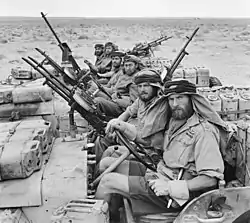
Light improvised fighting vehicles date back to the first use of automobiles, and to the horse-drawn tachankas mounting machine guns in eastern Europe and Russia. At the Bombardment of Papeete during World War I, the French armed several Ford trucks with 37 mm guns to bolster their defense of the city.[6] During the Spanish Civil War, field guns were fixed to lorries to act as improvised self-propelled guns, while improvised armoured cars were constructed by attaching steel plates to trucks.[7] During World War II, various British and Commonwealth units, including the Long Range Desert Group (LRDG), the No. 1 Demolition Squadron or 'PPA' (Popski's Private Army), and the Special Air Service (SAS) were noted for their exploits in the deserts of Egypt, Libya and Chad using unarmored motor vehicles, often fitted with machine guns. Examples of LRDG vehicles include the Chevrolet WB 30 cwt Patrol Truck[8] and the Willys MB Jeep.[9]
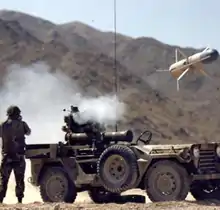
The SAS' use of heavily armed Land Rovers continued post war with their use of Series 1 Land Rovers and later Series 11A 1968 Land Rovers in the Dhofar Rebellion. The SAS painted their Land Rovers pink as it was found to provide excellent camouflage in the desert and they were nicknamed 'Pink Panthers' or Pinkies. The SAS also used a more modern Land Rover Desert Patrol Vehicle (DPV) during Gulf War 1.[10]
Western Sahara
Tactics for employing technicals were pioneered by the Sahrawi People's Liberation Army, the armed wing of the Polisario Front, fighting for independence against Mauritania (1975–79) and Morocco (1975–present) from headquarters in Tindouf, Algeria. Algeria provided arms and Land Rovers to Sahrawi guerrillas, who successfully used them in long-range desert raids against the less agile conventional armies of their opponents, recalling Sahrawi tribal raids (ghazis) of the pre-colonial period. Polisario later gained access to heavier equipment, but four-wheel drive vehicles remain a staple of their arsenal.
The Moroccan army quickly changed their strategy and created mounted units using technicals[11] to challenge Polisario speed and hit & run strategies in the large desert, where the Moroccan units proved their efficiency.
Chadian–Libyan conflict
In 1987, Chadian troops equipped with technicals drove the heavily mechanized Libyan army from the Aozou Strip. The vehicles were instrumental in the victory at the Battle of Fada, and were driven over 150 km (93 mi) into Libya to raid military bases. It was discovered that these light vehicles could ride through anti-tank minefields without detonating the mines when driven at speeds over 100 km/h. The vehicles had become so famous that, in 1984, Time dubbed early stages of the conflict the "Great Toyota War".[12]
The Toyota War was unusual in that the force equipped with improvised vehicles prevailed over the force equipped with purpose-built fighting vehicles. MILAN anti-tank guided missiles provided by France were key to the Chadian success, while the Libyan forces were poorly deployed and organized.
The Troubles in Northern Ireland
Throughout the conflict in Northern Ireland (1960s-1998), the Provisional IRA fitted vehicles, specially vans and trucks, with heavy machine guns and improvised mortars. See: Improvised tactical vehicles of the Provisional IRA.
Somali Civil War
Technicals played an important role in the 1990s Somali Civil War and the War in Somalia (2006–2009). After the fall of the Siad Barre regime and the collapse of the Somali National Army (SNA), it was rare for any Somali force to field armored fighting vehicles. However, technicals were very common.
Somali faction leader Mohamed Farrah Aidid used 30 technicals along with a force of 600 militia to capture Baidoa in September 1995.[13] After he was killed in clan fighting in 1996, his body was carried to his funeral on a Toyota pickup.[14]
Proving their susceptibility to heavy weapons and their value as a military prize, the Islamic Courts Union (ICU) was able to capture 30 "battlewagons" during the defeat of warlord Abdi Qeybdid's militia at the Second Battle of Mogadishu in 2006.[15] That September, an impressive array of 130 technicals was used to take Kismayo from the forces of the Juba Valley Alliance.[16]
On November 13, 2006, then President of Puntland, General Adde Musa, personally led fifty technicals to Galkacyo to confront the Islamists. They were used a month later against the army of the Islamic Courts Union at the Battle of Bandiradley alongside Abdi Qeybdiid's reconstituted militia.[17]
However, forced into conventional battles in the War in Somalia (2006–2009) the unarmored technicals of the ICU proved no match for the T-55 tanks, Mil Mi-24 helicopter gunships and fighter-bombers employed by Ethiopia.
War in Afghanistan
In the War in Afghanistan, U.S. special forces are known to use technicals for patrol of the rugged terrain and the nature of their clandestine operations.[18] The Taliban also used technicals while they were in power.[19][20]
Iraq War
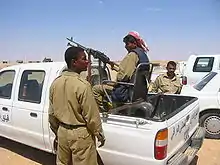
Technicals were used by Iraqi military forces in the 2003 invasion of Iraq.[21] The Iraqi Republican Guard and Fedayeen emulated tactics of the Somali National Alliance with limited success,[22][23] but were outmatched by Coalition armor and aviation.[24][25] In the aftermath of the invasion technicals saw use by Iraqi insurgents for transporting personnel and quick raids against the Iraqi police forces. The insurgent use of technicals increased after the Iraq Spring Fighting of 2004.
Many military utility vehicles have been modified to serve as gun trucks to protect Coalition convoys. The Humvee allows for weapon mounts by design, so it is not considered a technical.
The Coalition also supplied technicals to the Iraqi police.[26] Private military contractors also use technicals and the United States military used modified Toyota Tacoma pickups (purchased from auto showrooms in the U.S. and modified before delivery) as well.[27]
Darfur conflict
Janjaweed militias use technicals on their raids against civilian villages in Darfur, Sudan,[28] as do the Sudan Liberation Army (SLA) and Justice and Equality Movement (JEM) rebel troops in defense of their areas of operations.[29] Light vehicles such as technicals are often thought to be more mobile than armored vehicles, but on one occasion an African peace-keeper driving a Grizzly AVGP whose guns had jammed, succeeded in catching up with, ramming and rolling over a fleeing Sudanese technical.[30]
Lebanon
Introduced by the Palestine Liberation Organization (PLO) guerrilla groups, technicals were extensively employed by all factions involved in the Lebanese Civil War between 1975 and 1990, including the Christian Lebanese Front and Muslim Lebanese National Movement (LNM) irregular militias, the Lebanese Army and the Internal Security Forces (ISF). Opposition forces have reportedly used technicals in the fighting for the Chouf District during the May 2008 clashes in Lebanon.[31]
Libyan civil war
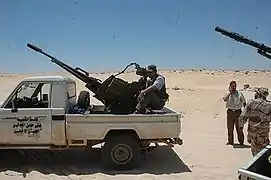
During the Libyan Civil War, both regime loyalist forces as well as the anti-Gaddafi forces used technicals extensively. The type of warfare that had been carried out in the conflict—wherein highly mobile groups of soldiers and rebels continued to move to and from on the desert terrain, retreating at a time and then suddenly attacking to regain control of small towns and villages in the Eastern rebel held parts of Libya—had led to the technical becoming a vehicle of choice for both sides.
Technicals had also been widely used by the rebels whilst setting up checkpoints. It also formed a vast percentage of the rebel inventory which was limited to light weapons, light body armor and very few tanks. Some medium flatbed trucks carried the Soviet-made ZPU and ZU-23-2 towed anti-aircraft twin or quad barreled guns, as well as recoilless rifles and S-5 rocket helicopter rocket launcher pods.[32] Some rebels have improvised with captured heavy weaponry, like BMP-1 turrets[33] and helicopter rocket pods, as well as lower-tech methods such as using doorbells to ignite rocket-launched ammunition.[34] Rebel technicals have also frequently employed BM-21 Grad rockets. Rocket tubes were salvaged from damaged regime Ural-375D trucks and mounted on the backs of pickups, with the technicals able to fire anywhere from one to six rockets.[35][36][37]
Syrian Civil War
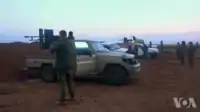
In the ongoing Syrian Civil War, technicals are extensively used as improvised fighting vehicles, especially by opposition forces and the Al-Nusra Front, who largely lack conventional fighting vehicles. Syrian government forces also use technicals, but on a smaller scale. The kind of weapons mounted on technicals varies widely, including machine guns, recoilless rifles, anti-aircraft guns (commonly ZPU and ZU-23-2) and even BMP-1 turrets. The Military of ISIL extensively uses technicals in Iraq and Syria.
Peshmerga forces have used technicals to surround and attack ISIS targets.[38]
War in Donbass
According to Gazeta.ru, during the 2014 war in Donbass both sides were using home-made military vehicles.[39]
Yemeni Civil War
During the Yemeni Civil War (2015-present) Houthis and Hadi-aligned militias use technicals.
Composition
Technicals consist of weapons mounted on a four-wheel drive pickup truck. Many pickups have been used as technicals including Ford Ranger and Mitsubishi Triton, but the most favoured are the Toyota Hilux and Toyota Land Cruiser. They are typically fitted with heavy machine guns (especially the DShK and M2 Browning), anti-aircraft artillery (usually the ZPU or ZU-23-2), recoilless rifles (usually the SPG-9 or M40 recoilless rifle), and multiple rocket launchers such as the Type 63 or the M-63 Plamen.
Optional add-ons include improvised vehicle armour such as welded steel plates defense against small arms fire.
See also
- Armadillo armoured fighting vehicle
- Boghammar
- Chariot - ancient equivalent
- Hit-and-run tactics
- Narco tank
- Portee
- Zamburak - Late medieval equivalent
References
- Neville, L.; Dennis, P. (2018). Technicals: Non-Standard Tactical Vehicles from the Great Toyota War to modern Special Forces. New Vanguard. Bloomsbury Publishing. pp. 4, 21. ISBN 978-1-4728-2252-9. Retrieved January 23, 2019.
- Drysdale, J. (2001). Whatever happened to Somalia?. HAAN. p. 47. ISBN 978-1-874209-51-5. Retrieved January 23, 2019.
- "Guerrilla Trucks: Why rebels and insurgent groups the world over love the Toyota Hilux pickup as much as their AK-47s". Newsweek. 2010-10-14. Retrieved 2010-10-25.
- "Somalia transitional government soldiers keep watch from a battlewagon over the parliament at Baidoa in November 2006, AFP Photo". News.yahoo.com. Retrieved 2011-07-06.
- "United States Psyop in Somalia, Herbert A. Friedman". Psywarrior.com. Retrieved 2011-07-06.
- Gudmundsson, Bruce I. (2004). On Armor. Westport, CT: Praeger Publishers. p. 2. ISBN 0-275-95019-0.
- Beevor, Antony. The Battle for Spain: The Spanish Civil War 1936-1939. Hachette UK, 2012.
- "Long Range Desert Group (LRDG)/ Special Air Services (SAS) Willys MB Jeep". War Wheels. Retrieved 2013-10-01.
- "Long Range Desert Group (LRDG)/ Special Air Services (SAS) Willys MB Jeep". War Wheels. Retrieved 2013-10-01.
- http://www.eliteukforces.info/special-air-service/mobility-troop/sas-land-rover/
- https://sahara-question.com/fr/videos/8500
- "The Great Toyota War". Time. 1984-04-23. Retrieved 2011-07-06.
- ""Aideed Forces Seize Somali City of Baidoa", Reuters, September 17, 1995 (copy hosted by". Africa.upenn.edu. Retrieved 2011-07-06.
- "Somalis bury Aydiid Archived 2006-11-18 at the Wayback Machine", Reuters, August 2, 1996 (copy hosted by netnomad.com).
- ""Somali Islamists win city battle", BBC News Online, 11 July 2006". BBC News. 2006-07-11. Retrieved 2011-07-06.
- "Content Not Found - Mail & Guardian". Retrieved 13 February 2015.
- ""Somalia: Puntland president deploys 50 battlewagons in Galkayo to avert Islamist fighters", Shabelle Media Network, 13 November 2006". Shabelle.net. 2010-11-03. Archived from the original on 2007-09-27. Retrieved 2011-07-06.
- Mizokami, Kyle. "The Toyota Pickup Truck Is the War Chariot of the Third World". /warisboring.com. Retrieved 24 February 2017.
- "The Taleban Response, Institute for War & Peace Reporting". Iwpr.net. 1980-07-07. Retrieved 2011-07-06.
- http://www.newsweek.com/why-rebel-groups-love-toyota-hilux-74195
- "Iraq Milnet.com". MILNET. Retrieved 2011-07-06.
- "How the Pentagon's promise of a quick war ran into the desert sand", The Guardian, March 28, 2003.
- "Hearing of the House Committee on Armed Services". Commdocs.house.gov. 2003-10-21. Retrieved 2011-03-29.
- John Pike (2003-03-20). "Operation Iraqi Freedom day 4". Globalsecurity.org. Retrieved 2011-03-29.
- John Pike (2003-03-20). "Operation Iraqi Freedom day 19". Globalsecurity.org. Retrieved 2011-03-29.
- "Iraqi Police Service Gets 'Technical' Vehicles, U.S. Department of Defense". Defendamerica.mil. Retrieved 2011-07-06.
- "How U.S. Special Forces Get Their Armored Pickups". Popular Mechanics. 2018-04-05. Retrieved 2020-08-30.
- Jerome Taylor, "Janjaweed ditches horseback to launch attacks from 4x4s" Archived 2007-01-08 at the Wayback Machine, The Independent, 8 December 2006. Accessed 14 August 2008.
- "Ryan Spencer Reed - Sudan Image Gallery". Retrieved 13 February 2015.
- "Background — AVGPs in Africa — Grizzlys and Huskys for Darfur". Canadian American Strategic Review. October 2009. Archived from the original on 2009-11-01.
- "Across the Bay". Retrieved 13 February 2015.
- "'No move zone' required to stop Gaddafi". Channel 4 News. Channel4.com. Retrieved 2011-03-29.
- Sam Biddle. "Crazily Brilliant Libyan Rebels Weld Tank Turret to Truck (And It Works!)". Gizmodo. Gawker Media. Retrieved 13 February 2015.
- "Libya's DIY Rebels Outfit Trucks With Copter Rockets - WIRED". WIRED. Retrieved 13 February 2015.
- http://www.acus.org/content/rebel-fighter-celebrates-his-comrades-fire-rocket-barrage-toward-gaddafi-forces-west-ajdabiy
- "Libya: Gaddafi's troops attack rebel-held towns as humanitarian crisis deepens". The Daily Telegraph. London. 2011-04-18.
- "Heavy clashes continue in Libya (0:50)". Reuters.
- "Technicals: the vehicles that changed the asymmetric conflicts - GEOPOLITICA.infoGEOPOLITICA.info". geopolitica.info (in Italian). Retrieved 2017-07-04.
- "Ñàìîäåëüíûå áðîíåàâòîìîáèëè Äîíáàññà". Ãàçåòà.Ru. Retrieved 13 February 2015.
External links
| Wikimedia Commons has media related to Technicals (vehicle). |
- Somali Technicals and AFV Photos
- A World of Dust
- Road Warrior Journeyman Pictures, 1 September 1995; 50 minute documentary regarding technicals of Mogadishu
.png.webp)